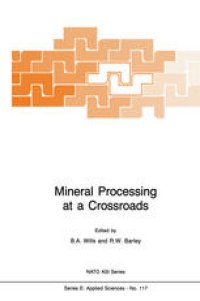
Ebook: Mineral Processing at a Crossroads: Problems and Prospects
- Tags: Characterization and Evaluation of Materials
- Series: NATO ASI Series 117
- Year: 1986
- Publisher: Springer Netherlands
- Edition: 1
- Language: English
- pdf
Due to the increasingly complex mineralogy, and lower grade of many current ore reserves, technology has, over the past decade, had to evolve rapidly to treat these materials economically in an industry which has undergone severe periods of recession. However, most of the technical innovations, such as the increasing use of solvent-extraction, ion-exchange etc., have been in the field of chemical ore processing, and, apart from the use of computers and ever larger unit process machines, there have been few major evolutionary changes in the field of physical mineral processing, where conventional crushing and grinding methods, essentially unchanged in half a century, are followed by the 'old-faithfuls'- flotation, gravity, magnetic and electrostatic methods of separation. Many of these techniques have major limitations in the treatment of 'new' ores such as complex sulphides, and the main purpose of the NATO Advanced study Institute (ASI) "Mineral Processing at a Crossroads" was to review the future of mineral processing. One of the great failings of physical methods is their inability to treat ultra-fine particles, and much research effort is required in this area. Flotation is still the most widely used and researched method for separating minerals, and is the only method which can be used to produce separate concentrates from complex sulphide ores. However, its performance on these 'modern' ores is poor, and it is in this area particularly that chemical methods will increasingly be integrated into plant circuits.
Content:
Front Matter....Pages I-VII
An Overview of the Ultrafine Problem....Pages 1-36
Dissolved — Air and Electrolytic Flotation....Pages 37-69
Fine Coal Cleaning — Achievements and Possibilities....Pages 71-88
Simulation - The Design Tool for the Future....Pages 89-116
Emerging Automatic Control Approaches in Mineral Processing....Pages 117-132
Energy Usage in Mineral Processing....Pages 133-155
Complex Sulphide Ores: Processing Options....Pages 157-194
Tin Mineralisation in Southwest England....Pages 195-262
The Development of Methods of Treating Tin Ores in Cornwall....Pages 263-286
Magnetic Separation....Pages 287-315
Gravity Concentration In Modern Mineral Processing....Pages 317-338
Developments in Solid-Liquid Separation....Pages 339-381
Strategic Minerals — Their Impact on Mineral Processing Developments....Pages 383-413
Back Matter....Pages 414-427
Content:
Front Matter....Pages I-VII
An Overview of the Ultrafine Problem....Pages 1-36
Dissolved — Air and Electrolytic Flotation....Pages 37-69
Fine Coal Cleaning — Achievements and Possibilities....Pages 71-88
Simulation - The Design Tool for the Future....Pages 89-116
Emerging Automatic Control Approaches in Mineral Processing....Pages 117-132
Energy Usage in Mineral Processing....Pages 133-155
Complex Sulphide Ores: Processing Options....Pages 157-194
Tin Mineralisation in Southwest England....Pages 195-262
The Development of Methods of Treating Tin Ores in Cornwall....Pages 263-286
Magnetic Separation....Pages 287-315
Gravity Concentration In Modern Mineral Processing....Pages 317-338
Developments in Solid-Liquid Separation....Pages 339-381
Strategic Minerals — Their Impact on Mineral Processing Developments....Pages 383-413
Back Matter....Pages 414-427
....